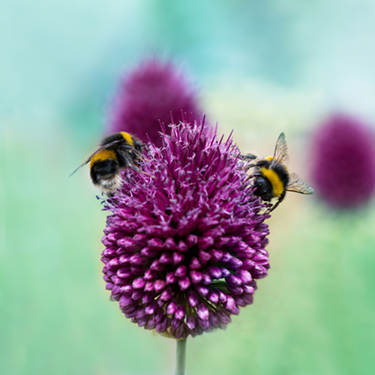Netherland Bulb Company
Known for producing Premium Holland Bulbs 1-800-78-TULIP
Bulbs & Bees
What bulbs best attract bees and pollinators to a garden? The answer is simple once one understands how a bee uses sight. Like humans, bees are trichromatic. Whereas humans base their color combinations on blue, red, and yellow, bees base their colors on ultraviolet light, blue, and green. As a result, bees cannot see the color red as they do not have a photoreceptor for it. Bees can see, however, a reddish wavelength such as yellow and orange, however, red appears as black to the eyes of a bee. Bees also see faster than humans, which in turn allow them to see individual flowers from a distance in large groups. As a result, scientists agree that a bee’s favorite colors are purple, blue and white.
Most bees, particularly honeybees, hibernate in winter by forming a cluster within their hive to keep the queen warm. They store food reserves for the winter months, and essentially blanket the queen until the temperatures begin to rise. As winter ends and spring slowly begins the need for food causes some to leave the hive and forage. By planting the right bulbs, home gardeners can not only attract pollinators to their gardens in early spring and throughout summer, but they can also provide food to a hive that is dealing with dwindling resources. Bees won’t travel too far in early spring, so home gardeners are best planting large areas of bulbs to create smaller distance for them to travel for pollen. For instance, plant bulbs like crocus in large swaths on the lawn to create a naturalistic setting, and also a bee playground.
Our suggestion for gardeners looking to attract bees would be of course blue and purple flowers. Red flowers can be placed intermittently throughout the landscape, but most bees will ignore them. Yellow and orange flowers are popular with bees, but a garden consisting only of those colors might not be as attractive to the bee eye, as it is to the human eye. Gardeners will do best to plant larger areas, however, combinations of alliums, hyacinth, muscari, and crocus will be equally as effective in offering bees a large variety of food in early spring. Chionodoxa, wood hyacinth, and scilla are also bee favorites that are typically deer and rabbit resistant for those who live in wooded areas. Galanthus and other white flowers are also popular with honeybees and bumblebees and offer a striking contrast to the blues and purples also loved by bees. Once bees begin to visit, they will return, providing pollination to the garden throughout the summer, and subsequent years.

